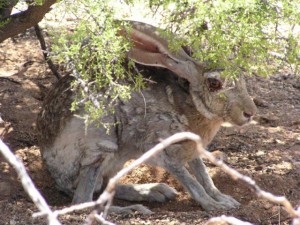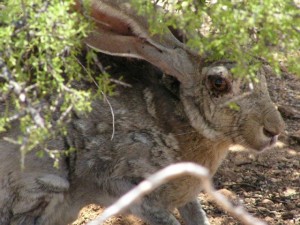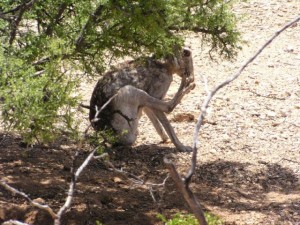Amazing creatures : The Antelope Jackrabbit
The amazing Antelope Jackrabbit is well adapted to survive in the Sonoran Desert, where temperatures regularly exceed 42 degrees Centigrade….
These images were taken on Thursday, August 7th, 2003. They show just how the Antelope Jackrabbit is able to blend in with its surroundings, in the Sonoran desert. The jackrabbit has chosen a shady resting place with the surrounding temperature exceeding 42 C.
Rather then run away, the jackrabbit has a habit of freezing in its place, and using its camouflage to evade detection. It did make a half-hearted attempt to move away, but obviously thought it was in no danger, as only ‘Mad dogs and Englishmen’ are known to be present in the midday sun! This was a real blessing, since I was able to find time to take the digital camera out of the backpack, and make adjustments, before taking these images. This was the first time I was able to take a series of photograph of the jackrabbit in its habitat.
Its long ears are important in temperature regulation. They represent 25% of the total surface area of the body. In this heat of Saguaro National Park, they are aimed upright, to allow maximum dissipation of heat from its body. It has also chosen a resting place beneath a creosote bush, where the temperature is lower than the open desert.
The main diet of the Antelope Jackrabbit consists of cactus pads, herbs and grasses. Its long legs enable it to reach higher branches of fresh vegetation. Most of its water requirements is extracted from the food it eats. This is indeed a useful mechanism to have for animals living in a desert!
Its main predator is the Coyote. Fortunately the jackrabbit is able to run, in bounding leaps, at speeds up to 65 km/hour. This leaping motion as it escapes from predators is the reason why it was named after the antelopes of the African plains.
All images: © Martyn Overy


